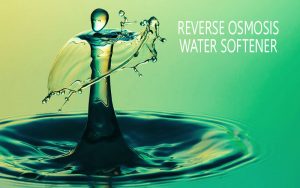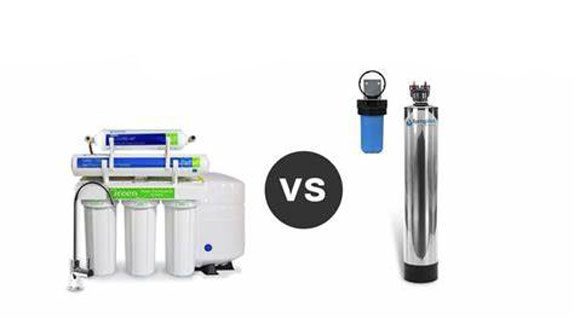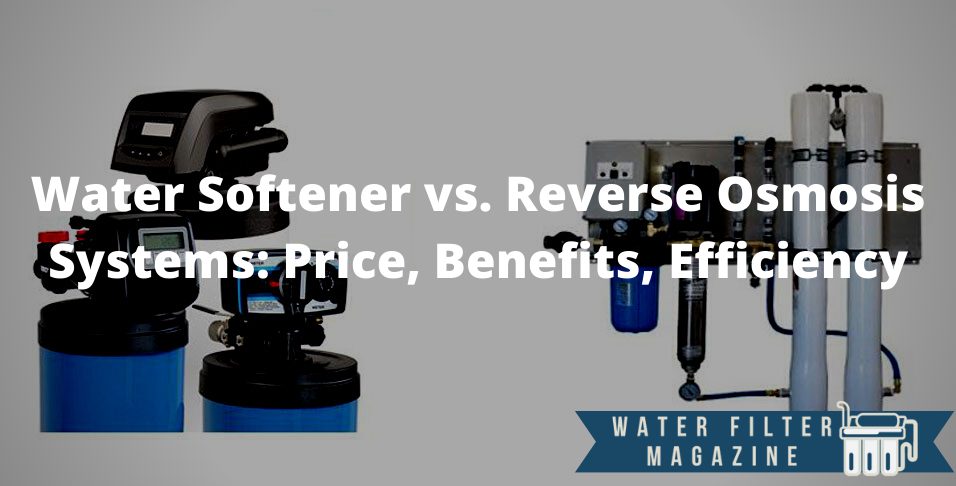A water softener is a system where minerals from the water are changed from hard minerals (i.e., calcium) to soft minerals (i.e., sodium), and reverse osmosis is a process where those minerals are filtered altogether. The difference between a water softener and a reverse osmosis system is that one relies on ionization to soften the water changing the structure of the particles, whereas the other takes the minerals out of the water altogether.
The main benefit of RO systems is that they are great when the water is relatively clean, making them a good choice for a home receiving municipal water. Water softeners are better for waters with high mineral content, making them a better choice for well water.
Water softeners are less expensive compared to a reverse osmosis system. Installing a whole house water softener can cost $2,500, whereas the price of installing a reverse osmosis system can reach $18,000.
Reverse osmosis systems have very small pore filters, meaning they can prevent bacteria and minerals from escaping. Their water filtration capacity is high. Water softeners do not necessarily filter, but they change the composition of the minerals. This makes the water softer while maintaining the mineralization of the water.
What Are the Differences Between Water Softeners and Reverse Osmosis?
 A reverse osmosis (RO) system will purify the water by using a series of filters. This process will reduce contaminants as small as 0.0001 microns. This includes minerals, salt, and other contaminants present in the water. The contaminants will be caught in the filter. Water softeners make use of ion exchange. This will replace the minerals from the water (i.e., calcium) that cause hardness, and replace them with potassium and sodium – i.e., salts. This process will make the water soft and remove the iron taste.
A reverse osmosis (RO) system will purify the water by using a series of filters. This process will reduce contaminants as small as 0.0001 microns. This includes minerals, salt, and other contaminants present in the water. The contaminants will be caught in the filter. Water softeners make use of ion exchange. This will replace the minerals from the water (i.e., calcium) that cause hardness, and replace them with potassium and sodium – i.e., salts. This process will make the water soft and remove the iron taste.
The main differences between water softeners and reverse osmosis systems are as follows:
- Level of filtration: Reverse osmosis removes more contaminants (i.e., bacteria and viruses) than water softening and purifies the water completely.
- Eco-friendliness: Water softeners lead to less water waste than reverse osmosis.
- Mineralization: Water softeners leave healthy minerals in the water.
- Maintenance: Water softeners need maintenance every few months while reverse osmosis may last up to a year.
- Material: Water softeners use salt in order to trigger the ionization process. Reverse osmosis systems use filters to capture all impurities altogether. This is done by means of a reverse osmosis membrane.
- Price: Water softeners have less complicated systems and processes. Because of this, they are more expensive. Reverse osmosis systems have a thorough impurity-removing process. This makes them more expensive.
- Success: Success depends on the quality of the water. If used on well water, success is higher with water softeners, as it can clean the water without waste. With RO systems, a lot of wastewater is produced. Reverse osmosis systems are more successful for municipal water, as this water has been previously treated with a sediment filter.
- Popularity: Both reverse osmosis systems and water softeners enjoy popularity. Water softeners have been used for a fairly long time. Reverse osmosis systems have only begun gaining popularity for better-tasting water.
- Part Count: Reverse osmosis systems are made of multiple filters. This means that one system will have at least around 3-4 parts: the filters and the body. Water softeners have fewer parts: a tank with the chemical solution and possibly a filter.
- Technology: Technology is more advanced with RO systems, as they remove 99% of the bacteria. They eliminate the minerals and add a healthy amount back. Water softeners have a different technology that uses ionization, softening the water.
- Usability: Reverse osmosis is used when the purpose is the removal of both bacteria and viruses along with minerals. Water softeners are only usable when the purpose is to remove minerals. They will likely not remove organic contaminants from the water.
- Weight: Water softeners are typically heavier due to the sizable tank. Reverse osmosis systems only use filters, so the system in itself is not very heavy. With water softeners, once the tank is full of salt or the ionization agent, it will become heavier.
- Installability: Installability differs on the type of water softeners or reverse osmosis systems. Reverse osmosis systems are often easier to install, as the system is smaller, and the parts are interconnected. Water softeners are easier to connect, but the tank may prove more difficult to carry. A countertop system, no matter if it is a water softener or a reverse osmosis system, will usually be very easy to install.
What Are the Unique Sides of Water Softeners Compared to Reverse Osmosis?
Water softeners use ionization to replace the magnesium and calcium from the water with sodium. The process involves adding a certain chemical in the water that will encourage the ionization of the water. Compared to reverse osmosis systems, water softeners will replace the calcium and minerals from the water with potassium and sodium. The process is done through ion exchange, which will make the water soft.
How does reverse osmosis work in comparison? Rather than replacing the minerals, it removes them entirely. Water softeners will leave the calcium and minerals there, albeit changed in structure, whereas with a RO system, they will be caught in the filter.
The following advantages make water softener systems unique when compared to RO systems:
- Natural Taste: Water softener removes most of the dissolved minerals from the water and replaces them with sodium and potassium. This will remove the metallic taste from the water, maintaining good mineral levels. This does not happen with RO filters, as the minerals are completely removed.
- Dissolved Mineral Removal: Water softeners can remove the minerals and contaminants that are already dissolved in the water. Compared to RO water systems, the smaller particles do not escape.
- Ease of Maintenance: Water softeners are easy to install and maintain. All that needs to be done is to add the water softening agent when it runs out.
Water softeners are unique because instead of filtering completely, they replace. This will maintain the healthy levels of the water while removing the contaminants. The water will have a natural taste.
What Are the Unique Sides of Reverse Osmosis Compared to Water Softeners?
 Reverse osmosis systems use filters to physically remove contaminants from the water. This includes contaminants as small as 0.0001 microns. The result is better-tasting water with few contaminants. Once users understand what a water softener is, they should also note the benefits of a RO system.
Reverse osmosis systems use filters to physically remove contaminants from the water. This includes contaminants as small as 0.0001 microns. The result is better-tasting water with few contaminants. Once users understand what a water softener is, they should also note the benefits of a RO system.
The unique sides of reverse osmosis systems, when compared to water softeners, are:
- Removes Contaminants without Chemicals: Reverse osmosis systems remove contaminants through filters. This means that no chemicals will be used to remove the contaminants.
- Leaves Water Tasteless: Reverse osmosis systems remove minerals from the water. Minerals are often the cause of weird tastes in the water. A reverse osmosis system will remove the source of any awkward taste.
- Leaves Water Odorless: Not only does reverse osmosis remove taste, but it also removes the odor. Minerals and chlorine are often a cause of the odor, and reverse osmosis will remove them from the root.
- High Filtering Capacity: Reverse osmosis filters have 0.0001-micron pores, which are the smallest. This means that reverse osmosis systems will remove even the smallest contaminants from the water.
Reverse osmosis systems are a good option when the aim is to remove the contaminants from the water naturally.
Is Reverse Osmosis Better for Softening Water?
Yes, reverse osmosis is better at softening water than water softeners. Reverse osmosis completely removes the minerals from the water, whereas water softeners replace them with softer minerals through ionization. Water going through reverse osmosis is entirely filtered of the minerals hardening the water. So, does reverse osmosis soften water better? Yes, but it removes the other healthy minerals as well.
Is a Water Softener Better than Reverse Osmosis for Well Water?
Yes, water softeners are typically better for well water. This applies especially to areas where the water hardness is high. Reverse osmosis systems can be used for well water, but the water hardness will cause the reverse osmosis filter to wear out faster. It will also waste a lot of water. For this reason, it is recommended to use water softeners.
Is a Water Softener Better than Reverse Osmosis for Home?
Yes, a water softener is better than reverse osmosis systems for home if there is hard water. In many cases, municipal water still retains high hardness, but will also have its taste and smell affected by chlorine and other bacteria-killing chemicals.
If the home water hardness is high, a water softener is better than a reverse osmosis system. If the problem is strange taste due to other contaminants aside from minerals, a reverse osmosis system may be a much better solution. The best water filters for home will remove the impurities altogether.
Is Reverse Osmosis More Expensive than Water Softener?
Yes, reverse osmosis systems are typically more expensive when compared to water softeners. This is because reverse osmosis membranes are more difficult to process. Additional costs may also be required for reverse osmosis systems, such as filters with a mineral bed. This will restore the good minerals removed from the water.
The type of water softener and reverse osmosis systems will also determine how expensive a product will be. A whole-house system will be more expensive compared to a point-of-use model. The wider the range, the higher the cost will be. The capacity of the filter and its extra features will also determine the cost.
The brand of the reverse osmosis system will also influence how expensive a product will be. For example, Waterdrop and NU Aqua provide high-end products with multiple features, making their options more expensive compared to APEC or iSpring.
What Is the Average Price for Reverse Osmosis?
Reverse osmosis systems cost between $12,000 and $18,000 if they are installed professionally. If installed by the homeowner, without paying a plumber, the RO system alone may cost between $150 and $600. This will also depend on the type of reverse osmosis system. A countertop reverse osmosis system is typically less expensive than an under-sink model. The difference does not go past $100.
What Is the Average Price for Water Softener?
The cost of a water softener may range between $800 and $2,500. This will depend on a variety of factors, such as their type, size, brand, and means of installation. If more labor is required to have the water softener installed, then the costs may go on the farther expensive range. If a plumber is not hired, prices can easily go under $100.
What Are the Brands for Reverse Osmosis?
The most popular brands for reverse osmosis systems are:
- Home Master: Home Master offers fine filtering equipment at affordable prices. They usually use granular carbon filters in their reverse osmosis systems as well as a patented re-mineralization system. Their RO systems incorporate a UV sterilizer as well, to kill viruses and bacteria that pass through the filter.
- Waterdrop: Waterdrop offers high-end products for people who are looking for a good quality reverse osmosis system. They often use cross-filtration in their system so that virus and bacteria buildup is prevented.
- NU Aqua: NU Aqua is popular for the fact that its membranes often last around 36 months. This is more than the average reverse osmosis filter. Easily adaptable and simple to install, they offer price-effective models that can last a long time.
What Are the Brands for Water Softeners?
The most popular brands for water softeners are:
- FutureSoft: Usually, water softeners use a salt-based system in order to trigger the ionization process. FutureSoft does not use salt systems. Instead, it uses Template Assisted Crystallization to crystalize the hard minerals, changing their chemical response. This means the products will not leave salt brine steaks after the filtration.
- SoftPro: SoftPro offers water softeners with a lifetime warranty. It uses safe chemicals and salt for the water softening process and it only requires a new load several times a year. Their systems are also very quiet, which makes them a favored choice for small homes.
- SpringWell: SpringWell usually produces salt-based softeners, claiming to exchange the lifespan of your appliances and preventing detergent loss by 40%. They are also popular for the fact that they create budget-friendly products.
What Are the Main Differences of Ion Exchange in Water Softener Compared to Reverse Osmosis?
Ion exchange involves adding a water softener, which will trigger the ion exchange process. Calcium and hard contaminants will be taken from the water and be transformed into magnesium and potassium ions. During this ion exchange process, the elements are not removed from the water but turned into something more beneficial.
With reverse osmosis systems, the elements are completely removed from the water. This includes dissolved minerals. Comparing reverse osmosis vs. ion exchange, they are not replaced but trapped in the RO filter. Every contaminant that is bigger than 0.0001 microns will be caught in the filter, cleaning it naturally without the use of chemicals.
What Are the Water Filtration System Types Other than Reverse Osmosis and Water Softener?
There are different types of water filtration systems available other than water softeners and reverse osmosis systems. In many cases, the filters are used in parallel with either of the systems. The following are the most common water filtration types:
- Sediment Filtration Systems: Sediment filtration systems are the most common water filtration types. They are regularly used in water filtration treatment and are usually used to treat municipal water. Sediment filtration systems capture contaminants from 1 to 100 microns, making them often used with water softeners.
- Ultrafiltration Systems: Ultrafiltration systems work similarly to reverse osmosis. The difference is in the pores of the filters. While reverse osmosis can capture contaminants as small as 0.0001, ultrafiltration is limited only to 0.01 microns.
- Ultraviolet Disinfection Filters: Ultraviolet technology is usually used to kill viruses and bacteria from the water. It is commonly used together with sediment filters and water softeners, as the smaller particles are not captured from the water.
- Activated Carbon Block Filters: Activated carbon block filters work as binding agents, removing taste and odor-causing contaminants from the water. They have a small pore size, inhibiting bacterial growth. Activated carbon filters are often a good alternative for reverse osmosis systems. They are also often used together with water softeners.
There are several differences between these water filtration system types, RO systems, and water softeners. In most cases, it involves the size of the filter. Reverse osmosis filters are smaller in pore size than sediment and ultrafiltration systems. Compared to ultraviolet and activated carbon filters, they do not kill bacteria entirely but trap and prevent it from passing. Also, when compared to water softeners, none of these water filtration systems lower water hardness that much.

